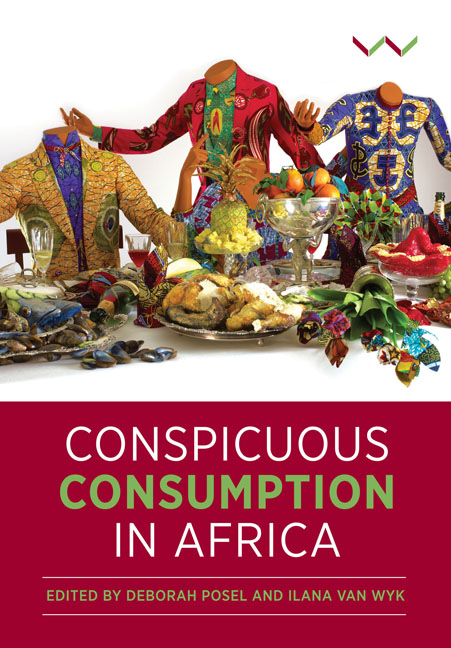Book contents
- Frontmatter
- Contents
- Acknowledgements
- List of Illustrations
- 1 Thinking With Veblen: Case Studies From Africa's Past and Present
- 2 Changes in the Order of Things: Department Stores and the Making of Modern Cape Town
- 3 Conspicuously Public: Gendered Histories of Sartorial and Social Success in Urban Togo
- 4 Etienne Rousseau, Broedertwis and the Politics of Consumption Within Afrikanerdom
- 5 Recycling Consumption: Political Power and Elite Wealth in Angola
- 6 Chiluba's Trunks: Consumption, Excess and the Body Politic in Zambia
- 7 Jacob Zuma's Shamelessness: Conspicuous Consumption, Politics and Religion
- 8 Precarious ‘Bigness’: a ‘Big Man’, His Women and His Funeral in Cameroon
- 9 Young Men of Leisure? Youth, Conspicuous Consumption and the Performativity of Dress in Niger
- 10 Booty on Fire: Looking at Izikhothane With Thorstein Veblen
- 11 Conspicuous Queer Consumption: Emulation and Honour in the Pink Map
- 12 The Politics and Moral Economy of Middle-Class Consumption in South Africa
- 13 Marigold Beads: Who Needs Diamonds?!
- Contributors
- Index
10 - Booty on Fire: Looking at Izikhothane With Thorstein Veblen
Published online by Cambridge University Press: 29 October 2019
- Frontmatter
- Contents
- Acknowledgements
- List of Illustrations
- 1 Thinking With Veblen: Case Studies From Africa's Past and Present
- 2 Changes in the Order of Things: Department Stores and the Making of Modern Cape Town
- 3 Conspicuously Public: Gendered Histories of Sartorial and Social Success in Urban Togo
- 4 Etienne Rousseau, Broedertwis and the Politics of Consumption Within Afrikanerdom
- 5 Recycling Consumption: Political Power and Elite Wealth in Angola
- 6 Chiluba's Trunks: Consumption, Excess and the Body Politic in Zambia
- 7 Jacob Zuma's Shamelessness: Conspicuous Consumption, Politics and Religion
- 8 Precarious ‘Bigness’: a ‘Big Man’, His Women and His Funeral in Cameroon
- 9 Young Men of Leisure? Youth, Conspicuous Consumption and the Performativity of Dress in Niger
- 10 Booty on Fire: Looking at Izikhothane With Thorstein Veblen
- 11 Conspicuous Queer Consumption: Emulation and Honour in the Pink Map
- 12 The Politics and Moral Economy of Middle-Class Consumption in South Africa
- 13 Marigold Beads: Who Needs Diamonds?!
- Contributors
- Index
Summary
Thorstein Veblen's (2003 [1899]) critique of the nineteenth-century American leisure class makes it apparent that their costly, wasteful and showy expenditure was, while somewhat distasteful, in keeping with class expectations of normal behaviour. While he did not focus on the so-called lower classes, he asserted that they did not stand outside the matrix of ‘honour’ mediated by conspicuous consumption. Although their consumption was constrained by more meagre incomes, they emulated the higher classes as they too vied for status (Veblen 2003: 58). The poor were marginal to Veblen's original thesis, as was a form of consumption that was virtually unknown in Veblen's time, namely the spectacular total destruction of expensive commodities by poor people in front of an assembled audience. The South African township youth subculture of ukukhothana (literally, ‘to lick’, figuratively in this context, ‘to boast’) involves groups of youths from disadvantaged socio-economic backgrounds theatrically destroying expensive consumer items in competitive dance-offs. The destructive conspicuous consumption of izikhothane (participants in ukukhothana) represents a fascinating case study of people who consume well beyond what they can comfortably afford, a possibility that Veblen did not explore.
BACKGROUND TO THE SUBCULTURE OF UKUKHOTHANA
Elements of ukukhothana have historical precedents in Europe and South Africa. During the Industrial Revolution, working class men who mimicked the dress of aristocrats were called dandies, a disparaging term for ‘pseudo-aristocrats’ (Botz-Bornstein 1995). As Corrigall (2015) argued, dandyism went beyond transgressing class boundaries: it was a political act that questioned the conventions that governed society. South Africa met its dandy in the mid-1880s in Kimberly with the rise of the so-called ‘diamond field dandies’ (Magubane 2004). Like their counterparts in Europe, the diamond field dandies sought to challenge social conventions, and especially the racially inscribed identities and stereotypes that were central to South African society at the time (Corrigall 2015). Mine work allowed black men ‘to buy certain markers of distinction’ (Magubane 2004) that until then were reserved for whites.
Seventy years later, a different kind of dandy emerged in Johannesburg. First visible in Jeppestown during the 1950s, oswenka (from the word ‘swank'l) were predominantly Zulu-speaking, working-class South African men who migrated to Johannesburg from the rural areas of KwaZulu-Natal.
- Type
- Chapter
- Information
- Conspicuous Consumption in Africa , pp. 168 - 182Publisher: Wits University PressPrint publication year: 2019



